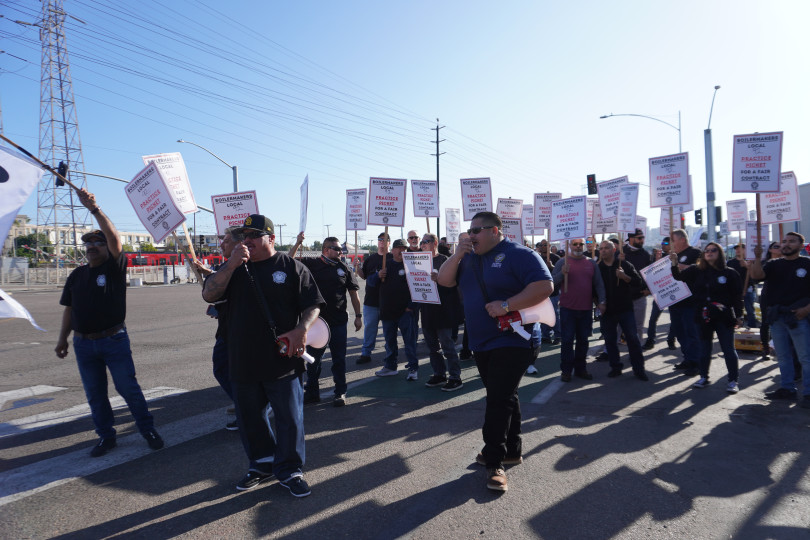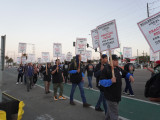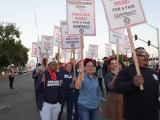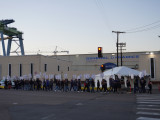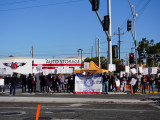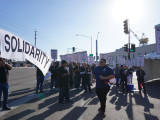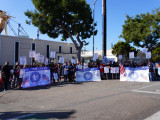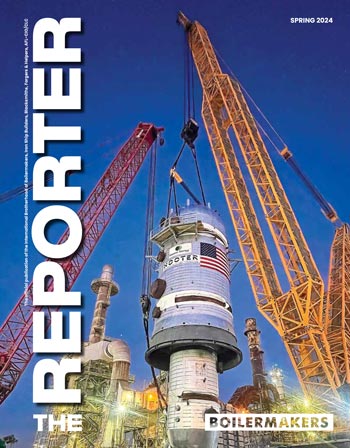“These are the workers who have been entrusted to build and repair our nation’s Naval ships. They deserve to be treated with far more respect than that.”
L-92 BM-ST Luis Miramontes (right, blue shirt) rallies Boilermakers in a practice picket outside the christening ceremony for the USNS Robert F. Kennedy at NASSCO shipyard.
View Photo Gallery (9 photos)
When General Dynamics NASSCO planned the christening ceremony for the USNS Robert F. Kennedy in San Diego, they probably didn’t picture a horde of Boilermakers and friends picketing as part of the festivities.
Nevertheless, contrasting the big day, as dignitaries and company VIPs patted themselves on the back and christened the vessel with champagne the morning of Oct. 28, hundreds of T-shirt-and-blue-jeans-clad Boilermakers nearby marched with signs and chanted, calling for a fair contract at NASSCO’s San Diego shipyard.
The practice picket was the second such action organized by Boilermakers in October as a show of collective frustration over the contract negotiation process with NASSCO. Over several months, as members demanded fair wages and fair treatment, NASSCO continually failed to produce a suitable contract.
The Boilermakers’ previous contract at NASSCO ended in September and was extended during negotiations. Members voted in favor of ratifying a new contract in early November just weeks after the practice pickets.
The union’s physical show of solidarity is a tactic that’s new to both its members and their employer.
“It was really important to get out there. A lot of our Boilermaker membership at the shipyard felt like their voices weren’t being heard,” said Luis Miramontes, BM-ST for Local 92 (Los Angeles). “When Local 92 got involved, we opened a door where they could let their voices be heard.”
Local 92 began representing NASSCO shipyard Boilermakers in late August and immediately went to work to help the union reclaim its strength in solidarity. According to members, previous leadership had become complacent in their representation, and members had grown accustomed to the union accepting whatever “as is” contract NASSCO offered.
“L-92 wasn’t even in place representing the NASSCO Boilermakers for a month when they came in with negotiations and hit the ground running,” said International Rep Jake Ludeman. “I think we’ve gained respect back. Maybe they forgot what it felt like to be part of a union and what a union is.”
NASSCO Boilermaker Joe Meyers confirmed Ludeman’s suggestion.
“It’s been pretty rewarding to see us working as a union with L-92 backing us up,” said Meyers, who has worked in NASSCO’s transportation division for 18 years. “L-92 has come in very strong, and it’s great to be a part of it. It’s stirring up a lot of excitement in the yard for the union—which I’ve never seen before.”
Of most importance to the NASSCO Boilermakers in their contract: fair wages and fair treatment. The shipyard is located in San Diego, which was recently named by U.S. News & World Report as the most expensive city to live in in America. Many Boilermakers, Miramontes explained, reside in Mexico where they can afford to live and provide for their families. They make a daily commute across the border. Because of the unpredictability of time needed to complete the border crossing, they often begin their journey as early as 1 a.m. and arrive in San Diego at 3 a.m.—where they then sleep in their cars in a parking lot.
“These are the workers who have been entrusted to build and repair our nation’s Naval ships,” Miramontes said. “They deserve to be treated with far more respect than that.”
Meanwhile, General Dynamics, NASSCO’s parent company, has received billions of dollars in federal funding.
“They are taking billions in federal contracts and not paying or treating their hard-working, highly skilled shipbuilders on par with other shipyards,” he said. “The White House has made it very clear that they don’t want to see federal contracts going to union busting.”
That’s why the union decided it was high time to flex the strength of members’ combined voices.
Efforts began with an Oct. 20 practice picket during lunchtime and between shifts as a way to test the waters on members’ interest in participating. Miramontes said the turnout was easily 500 Boilermakers and allies throughout the day. That action set the tone and paved the way for future action.
It also injected excitement for union participation in general. Miramontes said that when L-92 began representing at NASSCO, of the 1,300-some Boilermakers in the shipyard, 31% were dues-paying members. That number has grown to 50% and changing daily, with 140 new members signed within just a few weeks.
“We’re gaining membership, because people like what we’re doing here as a collective with membership and leadership,” Meyers said.
For Meyers, it’s also led to a new opportunity. For the first time in his career, he is on the negotiating committee, sitting at the table to represent his union. He said it’s been an educational experience and rewarding to learn how negotiations happen. He explained that the NASSCO shipyard includes five Boilermaker bargaining units, with collective bargaining agreements in transportation, steelwork, carpentry, painting and operating.
“I’m supporting transportation, where I work, and I’m doing my best to give it a fair shot,” he said. “I have high hopes for this with L-92’s support. In my 18 years here, nothing has come close to this.”
L-92 trustee chairman Nick Garcia said the key has been reminding members about the power they have as a union.
“The members now have a sense of pride in their local. They’ve been saying it themselves that it’s now a union,” he said. “They didn’t feel like they had a voice before. We want them to know they have a voice—because that’s what they do have.”
Exercising their voice has meant deciding for themselves what they find acceptable in a contract and then sticking together to fight for the contract they want and deserve from NASSCO. While they were seeing some positive movement in negotiations, the Boilermakers weren't yet satisfied with the contract.
To be clear, the picket was not a strike and no work was stopped for the action. The goal for both October practice pickets was to demonstrate to the company what a show of force looks like when the workers are united—to show what’s potentially at stake if the company fails to do right by its employees.
More than 250 Boilermakers and their families picketed outside the gate where the christening took place, carrying signs that read, “Practice Picket for a Fair Contract.” Several people dressed as Rosie the Riveter handed out leaflets and led chants of, “What would Rosie think?”
“The main message is that Boilermakers are here, and we’re here to make change with our brothers and sisters at NASSCO shipyard and to fight for their rights and interests every single day,” Miramontes said. “That’s with this contract and after this contract is ratified.”
Added Garcia: “I think the company is now realizing that they’re not dealing with the same local that was there before. They’ve taken notice that we’re bringing members together to create a better voice and that members are being represented the right way.”
Ludeman echoed those statements.
“If we hadn’t done these things, the members wouldn’t have been able to push to where we are now,” he said. “The company is going to have to respect us. We’re not going anywhere. We’re here for the long haul.”

